Introduction
This year is starting to be a great year for Rose Technics for their great releases such as the Star City 5 Pro, the QT9 Mk3, the Ceramics TWS and many more paving a way for users around the globe to appreciate their enthusiasm in making high performance audio in a reachable price. The Star City 5 Pro is surely one of my favourites V shaped IEM and they punch way above their asking price in every aspect. Recently in collaboration with HiFiGo, they have dive into the realm of portable audio dongle by being one of the first to adopt the all new Sabre flagship portable DAC chipset, the ES9039q2m, implemented into the RoseSelsa RS9039. The ES9039q2m is a continuation of the legendary ES9038q2m that is famed for being a technical beast by boasting an ultra low noise with a highly technical sound and Rose Technics is jumping on the wagon early with this RS9039 dongle.
A huge thanks to Silence from Rose Technics and HiFiGo for this opportunity to review this product. How will the RS9039 perform amongst several other brands of audio dongles? We shall find out here on Audiomonsta.
Functions & Specifications
Before we start the review, here are the specifications and features of the Rose Technics RoseSelsa RS9039;
- Sabre New Generation ES9039q2m
- CNC Aluminium Alloy Body
- Native DSD up to 256
- Low Noise LDO power chips
- Outputs: 4.4mm Balanced & 3.5mm Single-ended
- Power Output: 240 mW@32Ω 3.5mm SE, 300 mW@32Ω 4.4mm BAL
- Dimensions: 48mm x 22mm x 12mm
- THD+N: 0.0003% @ 1 kHz, 32 Ohms
- SNR: 126 dB @ 1 kHz, 32 Ohms
- Weight: 14.59 grams
Retail Price & Where to Get
The Rose Technics RoseSelsa RS9039 is sold exclusively on HiFiGo and can be bought via their website;
Packaging & Accessories
The RoseSelsa RS9039 packaging looks and feels premium for their asking price as it comes in an iridescent black box that is small but well packaged. Upon opening the box we are greeted with another matte box encasing a hard carrying case that is a very high quality one suitable for IEMs or to carry around the dongle itself. Accessories that are included are just a high quality USB C to C cable that has a cloth type sleeve, a user manual and the dongle itself. A case will be a good addition along with a USB C to B converter but given the low asking price with the Sabre chipset along with the included case, it is acceptable.

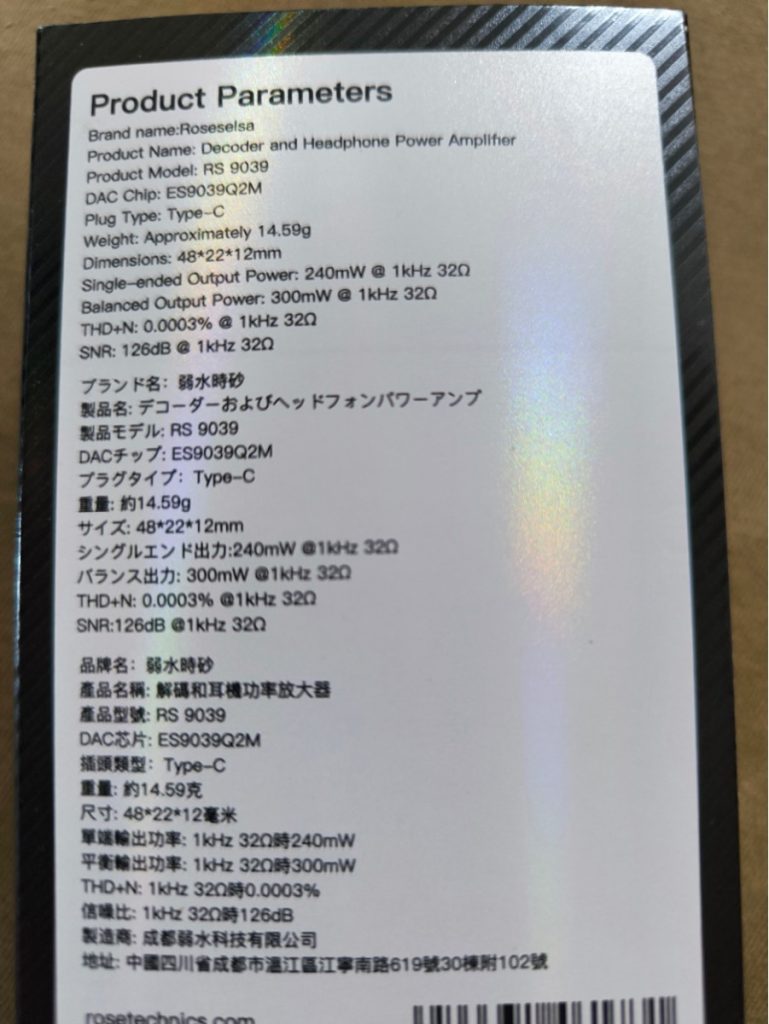




Design
The design of the RS9039 is futuristic, minimalistic and has a curvy body with rounded edges along. It has a very small footprint with a lightweight design that is very portable. They are made from CNC aluminium alloy and have a superb built quality that has a premium feel on hands. Only 1 colour is available and they are a matte silver grey colour. The printing of the branding here is actually quite nice and well designed with a schematic of the internals printed in the back which I and some geeks out there might be fond of. It is a straight forward, right to business dongle that doesn’t have any buttons nor gain switch that might be a deal breaker for some but not for me as I personally wouldn’t fiddle the settings on audio dongles as much.
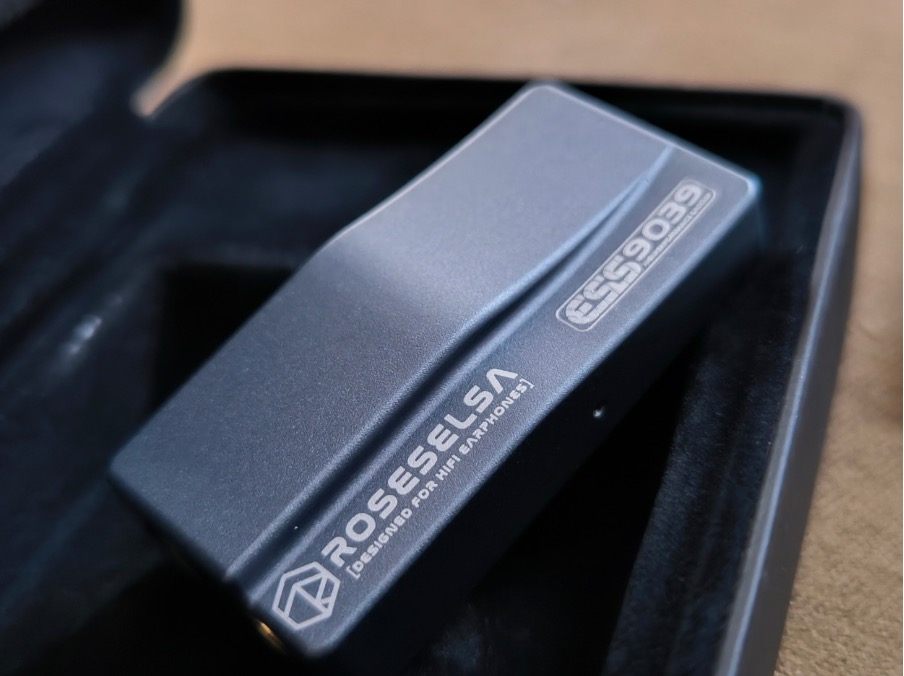
Under the hood is the main attraction of the RS9039 lies where the all new Sabre flagship portable DAC chipset is implemented, the ES9039q2m. It is an upgrade from the previous ES9038q2m that already has a legendary status for being one of having the best technicalities in the portable segment class. The ES9038q2m boasts a lower noise with a higher dynamic range along with better power efficiency than its predecessor and the RS9039 is coupled with LDO chips to further reduce the noise providing a black background for a cleaner output. It has a maximum power output of 300mv on balanced out which is great for the size and price.
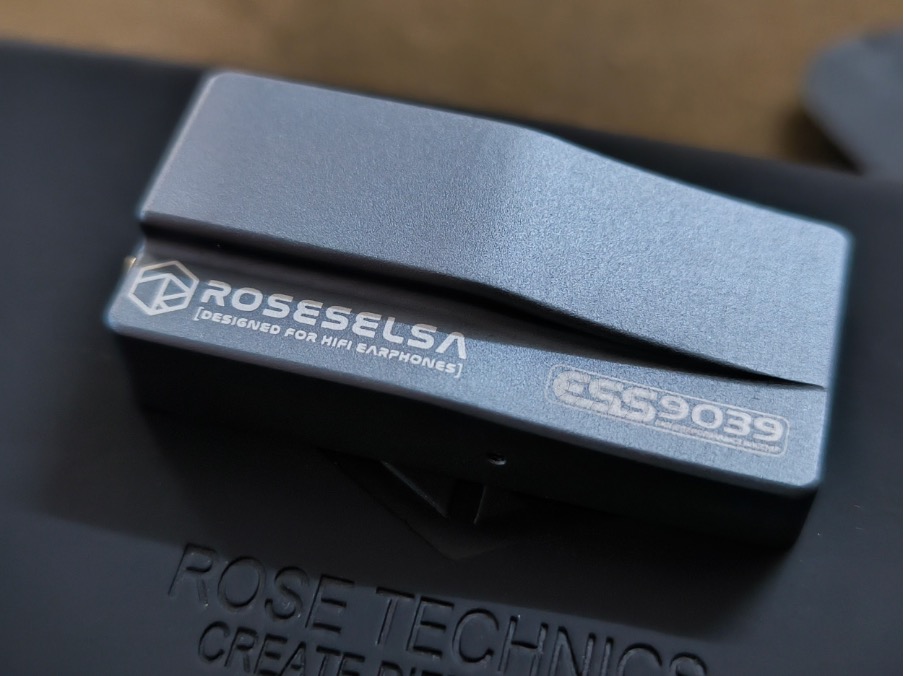
On the side we will have a LED indicator that will show white on standby and blue is playing. It doesn’t show the type of files played and no MQA support is available though.
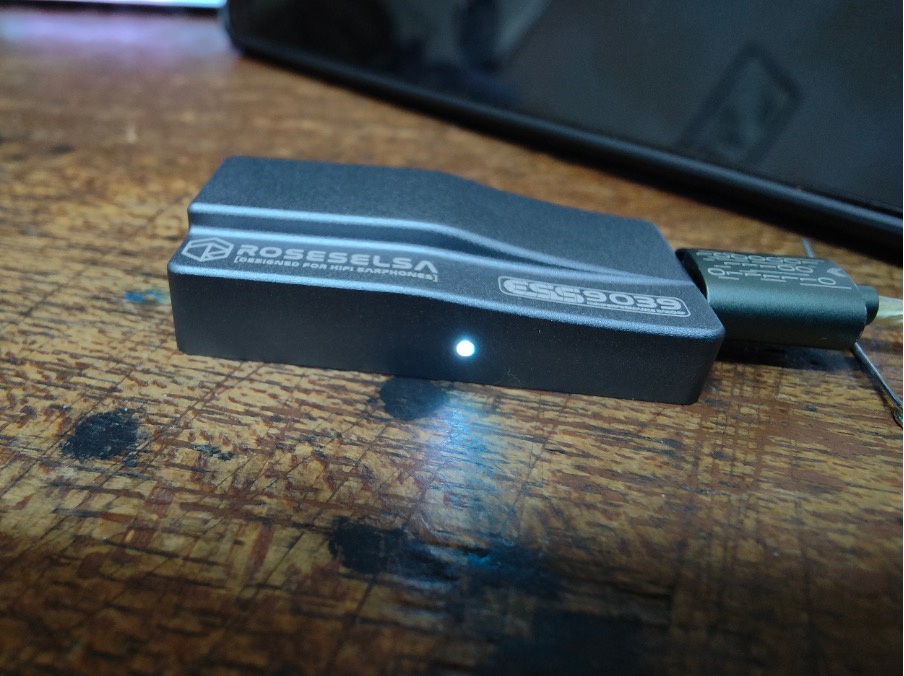
Below the unit is the usual type C digital input. The RS9039 is run by UAC 1.0 and does not need any driver while using a PC. It is worth noting that some USB C cables won’t work with this RS9039 and so far only my Ddhifi, FiiO and a few others do work, not really sure why though.
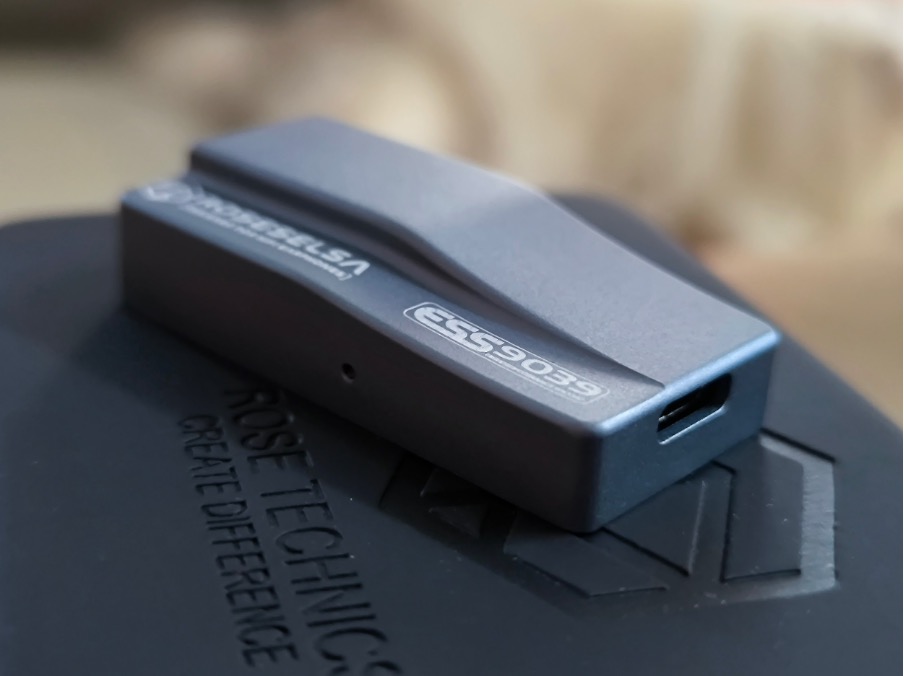
On the top we have a 3.5mm single ended and a 4.4mm balanced output. Both plugs are well made and have a secure fit.
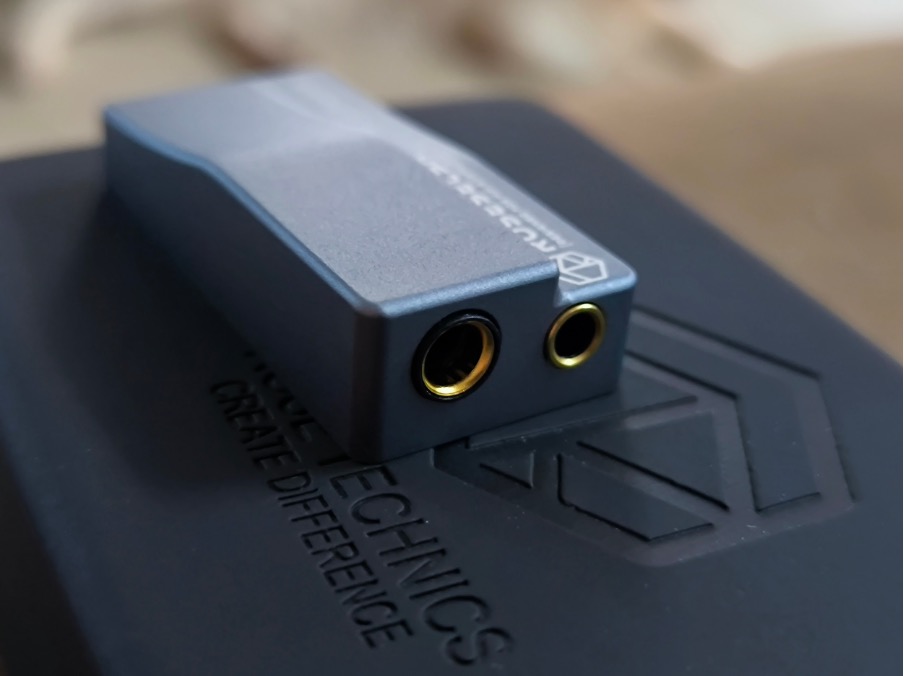
There isn’t any battery inside the RS9039 and it is powered by the source which have a surprisingly low power draw from the source similar to the Questyle M15 and the Colorfly CDA M1P which is rather good for a Sabre DAC and it might the most power efficient among the whole 90xx series. The unit does run slightly warm after a few hours but never hot in my usage.
Gears Used for Comparisons
FiiO Q7
Hiby FC6
FiiO KA3
Hidizs S9 Pro
Hidizs S8PRO Robin
Questyle M15
Colorfly M1P
Rudistor RP8
Sennheiser HD800s
Beyerdynamics DT1350
Moondrop A8
Dunu Luna
Hidizs MS3
Dunu EST112
Letshuoer S15
Blur daBass custom earbud
Toneking TO600
Songs list
Tone and Presentation
The tone of the RS9039 is a W shaped type of sound that has a neutral bright tone with some warmth that doesn’t have the usual Sabre glare, probably a fix from Sabre itself. It does have the pedigree of a Sabre technicalities with amazing details and clarity across all frequencies but this RS9039 does not sound as sterile as their siblings. Being a W shaped sound, it does have a rather aggressive sound that is energetic and fun to listen to while still preserving a clinically tuned sound signature.
Soundstage
The soundstage of RS9039 is good with a wide and an average tall sound to them that is competent in their price range. What sets them apart from the others is their amazing airy sound coupled with their wide dynamic range that makes music sound lively and full without any boxy sound. The headroom here is a medium sized headroom that is spacious giving a vivid 3D representation of music with an accurate placement of sound.
Separation and Timbre
Separation here is excellent as usual for the Sabre based sound and they have a great left to right separation with no crosstalk present on both outputs but with a slight edge leaning towards the balanced output. Texture and layering here is superb and they are able to keep with fast tracks such as EDM or metal with a breathy timbre. The timbre does have a brassy and sharp sound that gives music a good amount of bite and energy which produces a livelier sound but on the other hand, they aren’t as transparent of a sound.
Drivability
The driving power of the RS9039 is rated at a maximum of 300 mW on 4.4mm balanced and 240 mW on single ended which is good in their price segment but they are up against stiff of competition from the likes of the FiiO and Ibasso but they are still on par with some digital audio players costing 2 to 3 times their asking price. They are adequate for most IEMs, even with those hard to drive IEM like my Alpha Omega Ra and some portable headphones but with higher impedance big headphones like my Sennheiser HD800s, they do struggle to provide good dynamics albeit having enough volume. The output on both 3.5mm and 4.4mm has a superb low noise floor as advertised and even with highly sensitive IEM, they sounded black without any noise being picked up.
The Bass (Low)
Bass that the RS9039 produces is a boosted bass that has a good amount of mid bass lift that gives a big, authoritative bass response. It has a strong tight slam with an organic bass that sounds big with a good extension. Bass has a good weight and body and has a mild warm thickness to them giving a soulful presentation. Bleed is not present in the other frequencies and they are very well controlled. Details here are good with a great clarity and they are quite a resolving bass but transparency here is mediocre as they might be a little too much bass lift. Bass heads will find this frequency quite pleasing as the impact and amount of bass is rather big but they are not overpowering and bleed isn’t present in my usage. The pace of the bass is fast and they are energetic with a good aggressive signature. They aren’t for users who prefer a lean, accurate bass but suited for those who seek a fun bass. Sub-bass extension here is good with a deep and possessing a good amount of rumble.
The Mids
The midrange here is a forward neutral midrange that has a warm tone with a lush tone and a good degree of technicality. Details and clarity here is great alongside great detail retrieval capabilities in their macro and micro details. They are indeed a full sounding midrange and they do have a thick body to them which makes them an organic and intimate type of midrange with the forwardness. With this forward sound, they do lack a spacious midrange but they do have a good amount of air that have a good placement accuracy. Resolution here is vivid with some coloration and it gives a little more vibrant sound but on the other hand, the mids here isn’t a clinical sound for those who seek a pure clean sound which is what a Sabre based sound is known for. Transparency here is average but they do sound clean and clear without any being artificial. Vocals here are intimate with a more in your face style of vocals and they work very well with male or female vocals alike with their intimate sound with great brilliance. Overall, the midrange here is tuned more towards a fun, lush and sweet sound but they do lack a pure, accurate midrange that is usually present on a Sabre based DAC.
The Highs
The highs of the RS9039 is a mild boosted, neutral high range that has great energy but still very well in control. They have excellent detail along with crystal clear clarity without the usual Sabre chipset glare and they are indeed smooth sounding albeit being aggressive in this region. The high range here has a healthy dose of sparkle that has a crisp decay with a good amount of energy that gives music some bite and live. Treble heads like me really do enjoy this type of high range as I do feel its aggressiveness gives a more exciting sound but for those who are treble sensitive, the RS9039 might not be for you as it may get hot at times. Treble here surely has the intensity dialled up but it still manages to sound free of shout and peak but there is a little fatigue on higher volumes. Extension here is superb with a slow roll off at the end that gives a good amount of air. Transparency and resolution here is good with a vivid and clear sound that is rather accurate without any metallic sound.
Comparisons
VS Hidizs S8Pro Robin
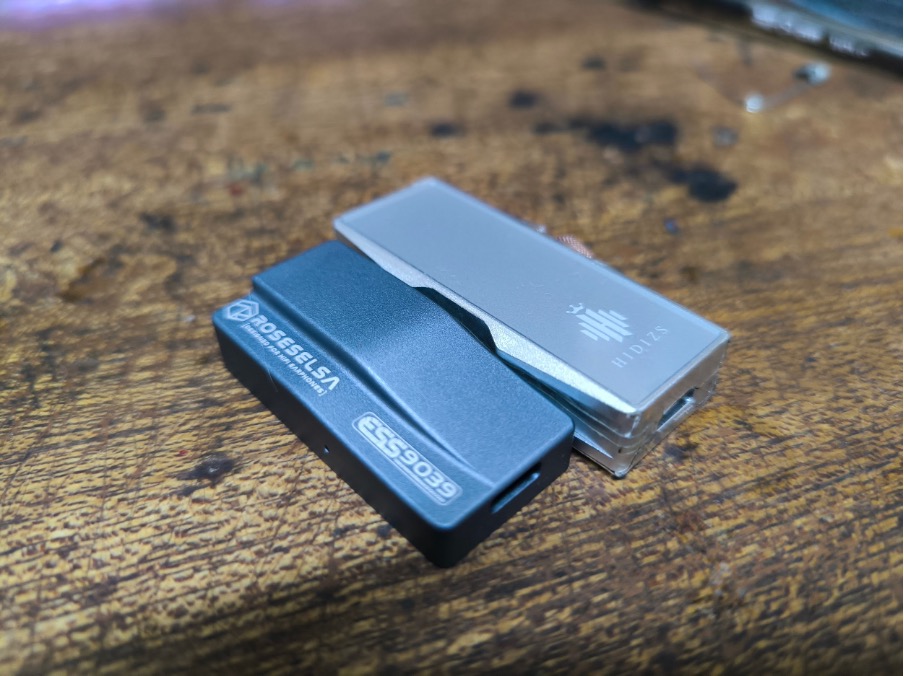
The latest budget oriented dongle from Hidizs named Robin. Equipped with 2 Cirrus Logic CS43131 that has excellent power efficiency with a smooth, laid-back sound but still technically inclined all at a low price. They are priced similarly to the RS9030 and the Robin does have a play/pause and volume controls. Both don’t have gain settings but the RS9039 has the leading hand in their driving power and they have a lower floor noise.
The high region on the RS9039 has a stronger, crisp type of presentation with a more intense treble. Details and clarity here is better on the RS9039 and they are more energetic while the Robin sounds smoother along with a more forgiving high range. The extension in the high range on the RS9039 is better with more air present. The Robin high range does sounds more organic and accurate versus the intense high range of the RS9039
Midrange on the RS9039 is thicker with a more musical sound that has a lusher mids versus the midrange of the Robin and details on the RS9039 is better with more clarity and they are more technical overall. Both have similar intimate mids but the Robin has a better balance overall versus the forward midrange of the RS9039. Resolution is better on the RS9039 but transparency seems better on the Robin.
Bass on the RS9039 has the edge of being more authoritative and has a more energetic presentation versus the slightly lean bass of the Robin. Details and clarity is also better on the RS9039 but bass accuracy is leaning towards the Robin for their correct, natural amount of bass. Extension on both is similar with a deep sub-bass performance but in terms of volume, the RS9039 does have a stronger rumble.
Soundstage on both of these units is similar with a good width and an average height but both are competitive in their price range.
VS FiiO KA3
The KA3 by FiiO is an older version of the KA series and they are equipped with the older version of Sabre DAC chipset, the ES9038q2m. They cost roughly the same and both have similar driving prowess along without any physical buttons but the KA3 can be configured via the FiiO application with gain settings and PEQ. The KA3 does drain some power from the source and the RS9039 does have a better power efficiency.
Bass on the RS9038 has a more organic and a warmer tone with slightly better details than the KA3 but the KA3 does have better clarity with a leaner bass. Texture on the bass of the RS9039 is better with a deeper bass and sub bass extension along with a bigger amount of sub-bass. The KA3 has a cleaner, tighter bass while the RS9039 has a thicker, authoritative bass that is more immersive and fun.
The RS9039 midrange is thicker, warmer and more intimate. Details here are similar with each other but overall details and transparency does sound better on the KA3 in a small margin. The KA3 midrange does sound thinny versus the RS9039 but KA3 doesn’t have the coloration thus they sound more accurate but lack lushness and body. Both are great in their resolving capabilities but the RS9039 does resolve marginally better.
High range on the RS9039 is smoother and has slightly better extension versus the slightly harsh and dry highs of the KA3. Sparkle is similar but the RS9039 manages to have a crisper sound and possess more air. Details and clarity here goes to the RS9039 with a cleaner and clearer high range overall.
Soundstage on both of these devices is quite similar which is great for the price paid but the RS9039 does have better air.
Synergy
Beyerdynamics DT1350
The portable DJ headphones from Beyerdynamics of Germany that might be the best in class of small portable headphones known for their portability and their superb passive noise isolation. They are a neutral bright sounding device with a mild bass boost that sounds clean and clear. They are relatively easy to drive and built like a tank typical of stuff from Beyerdynamics. The RS9039 does have ample driving power to drive these headphones with ease but for bigger headphones, they do seem to provide a good dynamic range.
Bass possesses a tighter slam and they have better dynamics with a stronger bass rumble. Sub-bass is great with a deeper extension with details and clarity slightly better. The added bass amount is a bit much for my liking but they are still in control without sounding overpowering with bleed present. Bass details and clarity remain intact along with the same resolution and transparency.
Midrange is slightly thicker and clearer with added details especially in the macro details side. Mid-range has a more spacious sound with better air present in the vocals region. Resolution wise is more vivid but transparency seems unchanged. Vocals do sound more intimate but lack depth.
Highs here are stronger but still sound smooth and they do sound more aggressive and have a sharper sparkle with a crisper decay. Due to the added amount of treble, the DT1350 does have some shout present and fatigue sets in after a long usage.
Soundstage is good but their width and height remains mostly the same. This pairing does provide some air in their presentation giving a spacious feel in these closed headphones.
Moondrop A8
The now classic discontinued 8 BA in-ears from Moondrop, the venerable A8 are my favourite in-ears from Moondrop as they have a top notch resolution sound with great coherent, dynamic sound that is truly inviting free of any dryness typical of a fully balanced armature set.
The bass of the A8 is tighter and has better extension in sub-bass with a slightly stronger bass slam. There is some added clarity here but detail retrieval remains the same. Mid bass here has a higher lift that gives a more dynamic type of bass on the A8.
Midrange had a more forward sound and they are thicker than usual with vetter details. Resolution is also slightly more vivid and they are slightly clearer. Vocals thickened with a deeper sound along with some brilliance added. Overall mids here sounds lusher and has better intimacy.
Highs of the A8 extend better and they sparkle better with a crisper sound. Details are more apparent but clarity is the same. There is some added air in their presentation that gives the A8 a livelier high range.
Soundstage is wider and taller with a slight increase in headroom.
Who Is It For?
The RoseSelsa RS9039 is a good option for users who want an exciting sound that is bold and energetic that still has great overall technicalities. They are a good portable dongle that has great power efficiency that has a low power drain from source and they are great for long travels. They do have strong lows with a thick, forward mids and a rather aggressive high range but they are still in control and will suit neutral to flat gears that need some extra bite in their presentation. Purists that want a clinical sound will find the RS9039 unappealing as they do have some coloration and their boosted frequencies may not sound as accurate. The lack of buttons and controls might deter users who want more options to play with but for those who seek simplicity, the RS9039 is the one for you. In terms of driving power, they are more than adequate for IEMs and easy to drive headphones but might struggle with higher impedance, low sensitivity headphones. They have a good immersive sound with accurate placements, therefore suiting those who are into gaming and for movies as well.
Final words
As Rose Technics is getting more and more active in the audio segment, their efforts are slowly being recognized for their enthusiasm in their products and the RoseSelsa RS9039 is one of their products that showcases the capabilities of their team. The RS9039 is one of the first to implement the new flagship Sabre ES9039q2m in a very budget friendly price and they are indeed a fresh sound from Sabre with a more inviting sound while keeping their great technicalities. It is surely a well designed and well built product that has a bold, energetic sound that makes music sounds more jovial. Yes there aren’t any buttons, applications or filters present but for some users like me who don’t fiddle much and prefer a simple, straightforward device, they are great. The sound might not suit those who yearn for a clinical, accurate sound for their coloration and aggression but the sound here is surely fun to listen to by providing an extra flavour into the gears you feed it and along with their ultra low noise, they are indeed a contender in this price range. A job well done for the team of Rose Technics and HiFiGo for the introduction of this product and I do hope they will continue to provide us with products like the RS9039 in the future.
I would rate this product a solid 4 over 5 stars
Pros
- Solid build and very well designed
- Ease of use, plug and play
- Small sized and lightweight
- Silent, black background
- Decent driving power
- Good musicality with a fun sound
- Good overall detail retrieving
- Decent warmth with good technical performance
- Good separation
- Authoritative bass
- Warm, thick and clean midrange
- Energetic high range
- Crisp high range
- Decent, airy soundstage
- Decent power efficiency, low power draw
- Packaged nicely with high quality case
Cons
- High range borderlining hissy
- Soundstage height a little short
- Tone be a little too warm and bassy
- No buttons, no gain settings
- Not a clinical performer
- Midrange mild coloration
- Mediocre transparency
- Some USB C cables won’t work
